In Vitro-Selected Clones of the Halophyte Arthrocaulon macrostachyum Display Enhanced Salinity Stress Tolerance
Abstract
1. Introduction
2. Methods
2.1. Plant Material and Glasshouse Cultivation
2.2. Determination of Biomass Production and Electrical Conductivity (EC)
2.3. Determination of Chlorophyll Fluorescence
2.4. Antioxidant Enzyme Activities
2.5. Antioxidant Activity Assay
2.6. Lipid Peroxidation
2.7. Mineral Nutrient Analysis
2.8. Statistical Analysis
3. Results and Discussion
3.1. Growth-Related Measurements
3.2. Mineral Nutrients
3.3. Chlorophyl Fluorescence Parameters
3.4. Antioxidant Metabolism and Oxidative Stress
4. Conclusions
Author Contributions
Funding
Data Availability Statement
Conflicts of Interest
References
- Flowers, T.J.; Colmer, T.D. Salinity Tolerance in Halophytes. New Phytol. 2008, 179, 945–963. [Google Scholar] [CrossRef] [PubMed]
- Flowers, T.J.; Colmer, T.D. Plant Salt Tolerance: Adaptations in Halophytes. Ann. Bot. 2015, 115, 327–331. [Google Scholar] [CrossRef]
- Ben Hamed, K.; Castagna, A.; Ranieri, A.; García-Caparrós, P.; Santin, M.; Hernandez, J.A.; Espin, G.B. Halophyte Based Mediterranean Agriculture in the Contexts of Food Insecurity and Global Climate Change. Environ. Exp. Bot. 2021, 191, 104601. [Google Scholar] [CrossRef]
- Robertson, J.A.; Deinlein, U.; Stephan, A.B.; Horie, T.; Luo, W.; Xu, G.; Schroeder, J.I.; Zhu, J.K.; Brief, P.; Tuteja, N.; et al. Halophyte Agriculture: Success Stories. Environ. Exp. Bot. 2015, 107, 71–83. [Google Scholar] [CrossRef]
- Hameed, A.; Hussain, S.; Rasheed, A.; Ahmed, M.Z.; Abbas, S. Exploring the Potentials of Halophytes in Addressing Climate Change-Related Issues: A Synthesis of Their Biological, Environmental, and Socioeconomic Aspects. World 2024, 5, 36–57. [Google Scholar] [CrossRef]
- Jurado-Mañogil, C.; Barba-Espín, G.; Hernández, J.A.; Diaz-Vivancos, P. Comparative Metabolomic Analysis between Tomato and Halophyte Plants under Intercropping Conditions. Physiol. Plant. 2023, 175, e13971. [Google Scholar] [CrossRef]
- Jurado, C.; Díaz-Vivancos, P.; Gregorio, B.E.; Acosta-Motos, J.R.; Hernández, J.A. Effect of Halophyte-Based Management in Physiological and Biochemical Responses of Tomato Plants under Moderately Saline Greenhouse Conditions. Plant Physiol. Biochem. 2024, 206, 108228. [Google Scholar] [CrossRef]
- Hasanuzzaman, M.; Raihan, M.R.H.; Masud, A.A.C.; Rahman, K.; Nowroz, F.; Rahman, M.; Nahar, K.; Fujita, M. Regulation of Reactive Oxygen Species and Antioxidant Defense in Plants under Salinity. Int. J. Mol. Sci. 2021, 22, 9326. [Google Scholar] [CrossRef]
- Hernández, J.A.; Ferrer, M.A.; Jiménez, A.; Barceló, A.R.; Sevilla, F. Antioxidant Systems and O2·-/H2O2 Production in the Apoplast of Pea Leaves. Its Relation with Salt-Induced Necrotic Lesions in Minor Veins. Plant Physiol. 2001, 127, 817–831. [Google Scholar] [CrossRef]
- Ball, P.W.; Cornejo, X.; Kaderet, G. Mangleticornia (Amaranthaceae: Salicornioideae)—A New Sister for Salicornia from the Pacific Coast of South America. Willdenowia 2017, 47, 145–153. [Google Scholar] [CrossRef][Green Version]
- Piirainen, M.; Liebisch, O.; Kadereit, G. Phylogeny, Biogeography, Systematics and Taxonomy of Salicornioideae (Amaranthaceae/Chenopodiaceae)—A Cosmopolitan, Highly Specialized Hygrohalophyte Lineage Dating Back to the Oligocene. Taxon 2017, 66, 109–132. [Google Scholar] [CrossRef]
- Murakeözy, E.P.; Aïnouche, A.; Meudec, A.; Deslandes, E.; Poupart, N. Phylogenetic Relationships and Genetic Diversity of the Salicornieae (Chenopodiaceae) Native to the Atlantic Coasts of France. Plant Syst. Evol. 2007, 264, 217–237. [Google Scholar] [CrossRef]
- Rodrigues, M.J.; Gangadhar, K.N.; Vizetto-Duarte, C.; Wubshet, S.G.; Nyberg, N.T.; Barreira, L.; Varela, J.; Custódio, L. Maritime Halophyte Species from Southern Portugal as Sources of Bioactive Molecules. Mar. Drugs 2014, 12, 2228–2244. [Google Scholar] [CrossRef]
- Duarte, B.; Caçador, I. Iberian Halophytes as Agroecological Solutions for Degraded Lands and Biosaline Agriculture. Sustainability 2021, 13, 1005. [Google Scholar] [CrossRef]
- Ramírez, E.; Rufo, L.; Sánchez-Mata, D.; Sánchez-Gavilán, I.; de la Fuente, V. Arthrocnemum macrostachyum plant communities in the Iberian Peninsula, Balearic and Canary Islands (Spain and Portugal). In Tools for Landscape-Scale Geobotany and Conservation. Geobotany Studies; Springer: Cham, Switzerland, 2021. [Google Scholar]
- Redondo-Gómez, S.; Mateos-Naranjo, E.; Figueroa, M.E.; Davy, A.J. Salt Stimulation of Growth and Photosynthesis in an Extreme Halophyte, Arthrocnemum macrostachyum. Plant Biol. 2010, 12, 79–87. [Google Scholar] [CrossRef]
- ElNaker, N.A.; Yousef, A.F.; Yousef, L.F. A Review of Arthrocnemum (Arthrocaulon) macrostachyum Chemical Content and Bioactivity. Phytochem. Rev. 2020, 19, 1427–1448. [Google Scholar] [CrossRef]
- Munir, N.; Hasnain, M.; Roessner, U.; Abideen, Z. Strategies in Improving Plant Salinity Resistance and Use of Salinity Resistant Plants for Economic Sustainability. Crit. Rev. Environ. Sci. Technol. 2021, 52, 2150–2196. [Google Scholar] [CrossRef]
- Custódio, L.; Charles, G.; Magné, C.; Barba-Espín, G.; Piqueras, A.; Hernández, J.A.; Ben Hamed, K.; Castañeda-Loaiza, V.; Fernandes, E.; Rodrigues, M.J. Application of In Vitro Plant Tissue Culture Techniques to Halophyte Species: A Review. Plants 2023, 12, 126. [Google Scholar] [CrossRef]
- Gulzar, B.; Mujib, A.; Qadir Malik, M.; Mamgain, J.; Syeed, R.; Zafar, N. Plant Tissue Culture: Agriculture and Industrial Applications. In Transgenic Technology Based Value Addition in Plant Biotechnology; Academic Press: New York, NY, USA, 2020. [Google Scholar]
- de Jesus Raposo, M.F.; de Morais, R.M.S.C. Micropropagation of the Halophyte Sarcocornia fruticosa (L.) AJ Scott. J. Basic Appl. Sci. 2021, 10, 53–59. [Google Scholar] [CrossRef]
- Yao, L.; Wang, J.; Yang, K.; Li, B.; Meng, Y.; Ma, X.; Lai, Y.; Si, E.; Ren, P.; Shang, X.; et al. In Vitro Regeneration System of Halogeton Glomeratus: An Important Halophyte. Vitr. Cell. Dev. Biol.-Plant 2021, 57, 332–340. [Google Scholar] [CrossRef]
- Vyas, K.D.; Ranawat, B.; Singh, A. Development of High Frequency Cost-Effective Micropropagation Protocol for Juncus Rigidus Using Liquid Culture Medium and Extraction of Cellulose from Their in Vitro Shoots—An Important Rush. Biocatal. Agric. Biotechnol. 2021, 35, 102099. [Google Scholar] [CrossRef]
- Joshi, M.; Mishra, A.; Jha, B. NaCl Plays a Key Role for in Vitro Micropropagation of Salicornia Brachiata, an Extreme Halophyte. Ind. Crops Prod. 2012, 35, 313–316. [Google Scholar] [CrossRef]
- Reyes-Vera, I.; Lucero, M.; Barrow, J. An Improved Protocol for Micropropagation of Saltbush (Atriplex) Species. Nativ. Plants J. 2010, 11, 53–56. [Google Scholar] [CrossRef]
- Regalado, J.J.; Tossi, V.E.; Burrieza, H.P.; Encina, C.L.; Pitta-Alvarez, S.I. Micropropagation Protocol for Coastal Quinoa. Plant Cell Tissue Organ Cult. 2020, 142, 213–219. [Google Scholar] [CrossRef]
- Larkin, P.J.; Scowcroft, W.R. Somaclonal Variation—A Novel Source of Variability from Cell Cultures for Plant Improvement. Theor. Appl. Genet. 1981, 60, 197–214. [Google Scholar] [CrossRef] [PubMed]
- Rai, M.K. Somaclonal Variation in Improvement of Agricultural Crops: Recent Progress. In Agricultural Biotechnology: Latest Research and Trends; Springer: New York, NY, USA, 2022. [Google Scholar]
- Jurado-Mañogil, C.; Díaz-Vivancos, P.; Hernández, J.A.; Piqueras, A.; Barba-Espín, G. Efficient In Vitro Platform for Multiplication, Acclimatization, and Deliver of High-NaCl-Tolerant Clones of the Halophyte Arthrocaulon macrostachyum. J. Plant Growth Regul. 2024, 43, 1631–1641. [Google Scholar] [CrossRef]
- Acosta-Motos, J.R.; Noguera-Vera, L.; Barba-Espín, G.; Piqueras, A.; Hernández, J.A. Antioxidant Metabolism and Chlorophyll Fluorescence during the Acclimatisation to Ex Vitro Conditions of Micropropagated Stevia rebaudiana Bertoni Plants. Antioxidants 2019, 8, 615. [Google Scholar] [CrossRef]
- McCord, J.M.; Fridovich, I. Superoxide dismutase. An enzymic function for erythrocuprein (hemocuprein). J. Biol. Chem. 1969, 244, 6049–6055. [Google Scholar] [CrossRef]
- Aebi, H. Cataiase In vitro. Methods Enzym. 1984, 185, 121–126. [Google Scholar]
- Ros-Barceló, A.; Gómez-Ros, L.V.; Ferrer, M.A.; Hernández, J.A. The apoplastic antioxidant enzymatic system in the wood-forming tissues of trees. Trees 2006, 20, 145–156. [Google Scholar] [CrossRef]
- Bradford, M.M. A Rapid and Sensitive Method for the Quantitation of Microgram Quantities of Protein Utilizing the Principle of Protein-Dye Binding. Anal. Biochem. 1976, 72, 248–254. [Google Scholar] [CrossRef] [PubMed]
- Dzhanfezova, T.; Barba-Espín, G.; Müller, R.; Joernsgaard, B.; Hegelund, J.N.; Madsen, B.; Larsen, D.H.; Martínez Vega, M.; Toldam-Andersen, T.B. Anthocyanin Profile, Antioxidant Activity and Total Phenolic Content of a Strawberry (Fragaria × Ananassa Duch) Genetic Resource Collection. Food Biosci. 2020, 36, 100620. [Google Scholar] [CrossRef]
- Cakmak, I.; Horst, W.J. Effect of aluminium on lipid peroxidation, superoxide dismutase, catalase, and peroxidase activities in root tips of soybean (Glycine max). Physiol. Plant. 1991, 83, 463–468. [Google Scholar] [CrossRef]
- Hernández, J.A.; Almansa, M.S. Short-Term Effects of Salt Stress on Antioxidant Systems and Leaf Water Relations of Pea Leaves. Physiol. Plant. 2002, 115, 251–257. [Google Scholar] [CrossRef]
- Polivanova, O.B.; Bedarev, V.A. Hyperhydricity in Plant Tissue Culture. Plants 2022, 11, 3313. [Google Scholar] [CrossRef]
- Bazihizina, N.; Colmer, T.D.; Cuin, T.A.; Mancuso, S.; Shabala, S. Friend or Foe? Chloride Patterning in Halophytes. Trends Plant Sci. 2019, 24, 142–151. [Google Scholar] [CrossRef]
- Colmenero-Flores, J.M.; Franco-Navarro, J.D.; Cubero-Font, P.; Peinado-Torrubia, P.; Rosales, M.A. Chloride as a beneficial macronutrient in higher plants: New roles and regulation. Int. J. Mol. 2019, 20, 4686. [Google Scholar] [CrossRef]
- Franco-Navarro, J.D.; Rosales, M.A.; Cubero-Font, P.; Calvo, P.; Álvarez, R.; Díaz-Espejo, A.; Colmenero-Flores, J.M. Chloride as macronutrient increases water use efficiency by anatomically-driven reduced stomatal conductance and increased mesophyll diffusion to CO2. Plant J. 2019, 99, 815–831. [Google Scholar] [CrossRef]
- Nieves-Cordones, M.; García-Sánchez, F.; Pérez-Pérez, J.G.; Colmenero-Flores, J.M.; Rubio, F.; Rosales, M.A. Coping with water shortage: An update on the role of K+, Cl–, and water transport mechanisms on drought resistance. Front. Plant Sci. 2019, 10, 1619. [Google Scholar] [CrossRef]
- Carmona, R.; Muñoz, R.; Niell, F.X. Differential Nutrient Uptake by Saltmarsh Plants Is Modified by Increasing Salinity. Front. Plant Sci. 2021, 29, 709453. [Google Scholar] [CrossRef]
- Barker, A.V.; Pilbeam, D.J. Handbook of Plant Nutrition; CRC Press: Boca Raton, FL, USA, 2016; pp. 1–773. [Google Scholar] [CrossRef]
- Maxwell, K.; Johnson, G.N. Chlorophyll Fluorescence—A Practical Guide. J. Exp. Bot. 2000, 51, 659–668. [Google Scholar] [CrossRef] [PubMed]
- Zhang, Q.Y.; Wang, L.Y.; Kong, F.Y.; Deng, Y.S.; Li, B.; Meng, Q.W. Constitutive Accumulation of Zeaxanthin in Tomato Alleviates Salt Stress-Induced Photoinhibition and Photooxidation. Physiol. Plant. 2012, 146, 363–373. [Google Scholar] [CrossRef] [PubMed]
- Sengupta, S.; Majumder, A.L. Insight into the Salt Tolerance Factors of a Wild Halophytic Rice, Porteresia coarctata: A Physiological and Proteomic Approach. Planta 2009, 229, 911–929. [Google Scholar] [CrossRef]
- Bose, J.; Rodrigo-Moreno, A.; Shabala, S. ROS Homeostasis in Halophytes in the Context of Salinity Stress Tolerance. J. Exp. Bot. 2014, 65, 1241–1257. [Google Scholar] [CrossRef] [PubMed]
- Bose, J.; Munns, R.; Shabala, S.; Gilliham, M.; Pogson, B.; Tyerman, S.D. Chloroplast function and ion regulation in plants growing on saline soils: Lessons from halophytes. J. Exp. Bot. 2017, 68, 3129–3143. [Google Scholar] [CrossRef]
- Halliwell, B. Reactive Species and Antioxidants. Redox Biology Is a Fundamental Theme of Aerobic Life. Plant Physiol. 2006, 141, 312–322. [Google Scholar]
- Del Rio, D.; Stewart, A.J.; Pellegrini, N. A Review of Recent Studies on Malondialdehyde as Toxic Molecule and Biological Marker of Oxidative Stress. Nutr. Metab. Cardiovasc. Dis. 2005, 15, 316–328. [Google Scholar] [CrossRef]
- Abd El-Maboud, M.M. Seasonal Variations Effect on Antioxidant Compounds and Their Role in the Adaptation of Some Halophytes at Wadi Gharandal, Southwest Sinai. Ann. Agric. Sci. 2019, 64, 161–166. [Google Scholar] [CrossRef]
- Osman, M.S.; Badawy, A.A.; Osman, A.I.; Abdel Latef, A.A.H. Ameliorative Impact of an Extract of the Halophyte Arthrocnemum macrostachyum on Growth and Biochemical Parameters of Soybean Under Salinity Stress. J. Plant Growth Regul. 2021, 40, 1245–1256. [Google Scholar] [CrossRef]
- Castillo, J.M.; Mancilla-Leytón, J.M.; Martins-Noguerol, R.; Moreira, X.; Moreno-Pérez, A.J.; Muñoz-Vallés, S.; Pedroche, J.J.; Figueroa, M.E.; García-González, A.; Salas, J.J.; et al. Interactive Effects between Salinity and Nutrient Deficiency on Biomass Production and Bio-Active Compounds Accumulation in the Halophyte Crithmum maritimum. Sci. Hortic. 2022, 301, 111136. [Google Scholar] [CrossRef]
- Oprică, L.; Vochița, G. Enzymatic Activity in Halophytes. In Handbook of Halophytes; Grigore, M.N., Ed.; Springer: Cham, Switzerland, 2021. [Google Scholar] [CrossRef]
- Ros Barceló, A.; Pomar, F.; López-Serrano, M.; Pedreño, M.A. Peroxidase: A Multifunctional Enzyme in Grapevines. Funct. Plant Biol. 2003, 30, 577–591. [Google Scholar] [CrossRef] [PubMed]
- Rajput, V.D.; Harish; Singh, R.K.; Verma, K.K.; Sharma, L.; Quiroz-Figueroa, F.R.; Meena, M.; Gour, V.S.; Minkina, T.; Sushkova, S.; et al. Recent Developments in Enzymatic Antioxidant Defence Mechanism in Plants with Special Reference to Abiotic Stress. Biology 2021, 10, 267. [Google Scholar] [CrossRef] [PubMed]
- Ghanem, A.E.M.F.M.; Mohamed, E.; Kasem, A.M.M.A.; El-Ghamery, A.A. Differential Salt Tolerance Strategies in Three Halophytes from the Same Ecological Habitat: Augmentation of Antioxidant Enzymes and Compounds. Plants 2021, 10, 1100. [Google Scholar] [CrossRef] [PubMed]
- Pirasteh-Anosheh, H.; Samadi, M.; Kazemeini, S.A.; Ozturk, M.; Ludwiczak, A.; Piernik, A. ROS Homeostasis and Antioxidants in the Halophytic Plants and Seeds. Plants 2023, 12, 3023. [Google Scholar] [CrossRef]
- Ievinsh, G. Halophytic Clonal Plant Species: Important Functional Aspects for Existence in Heterogeneous Saline Habitats. Plants 2023, 12, 1728. [Google Scholar] [CrossRef]
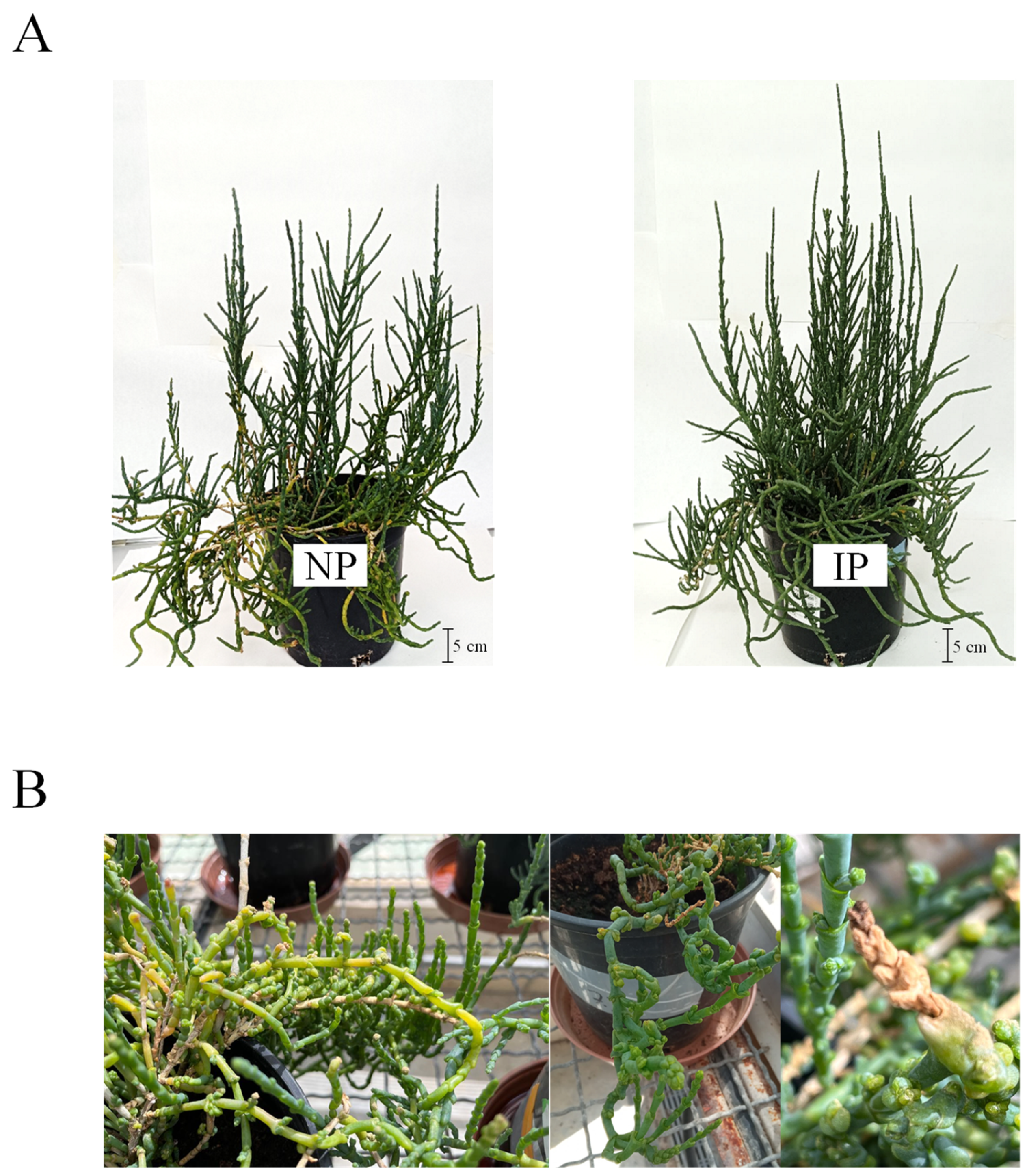
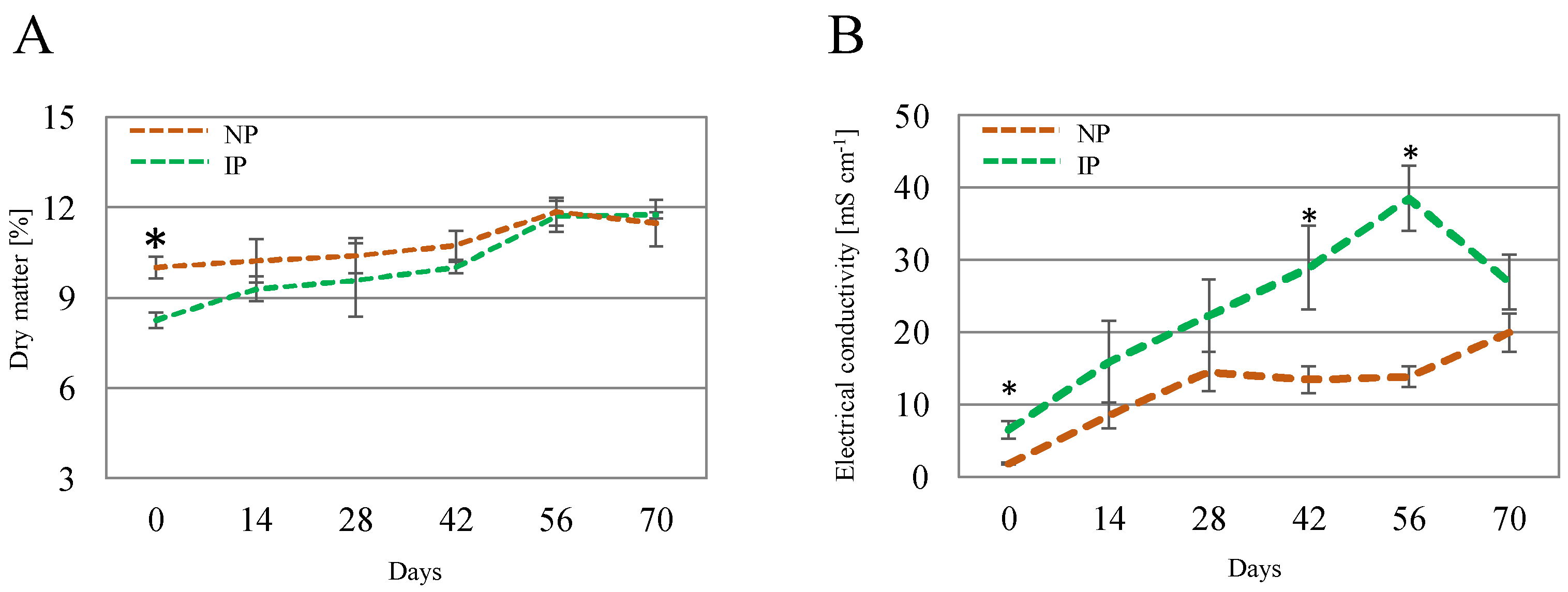
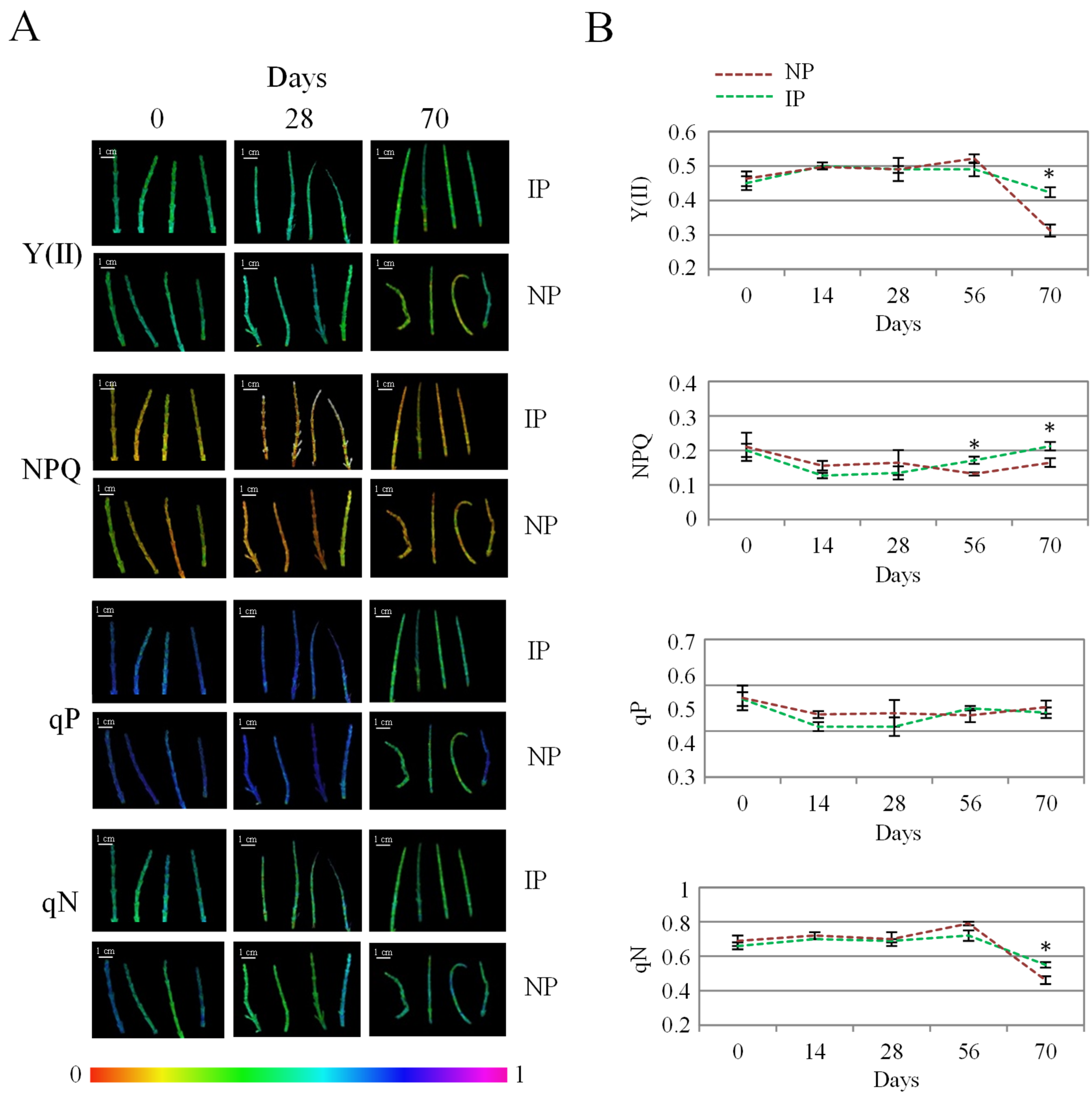
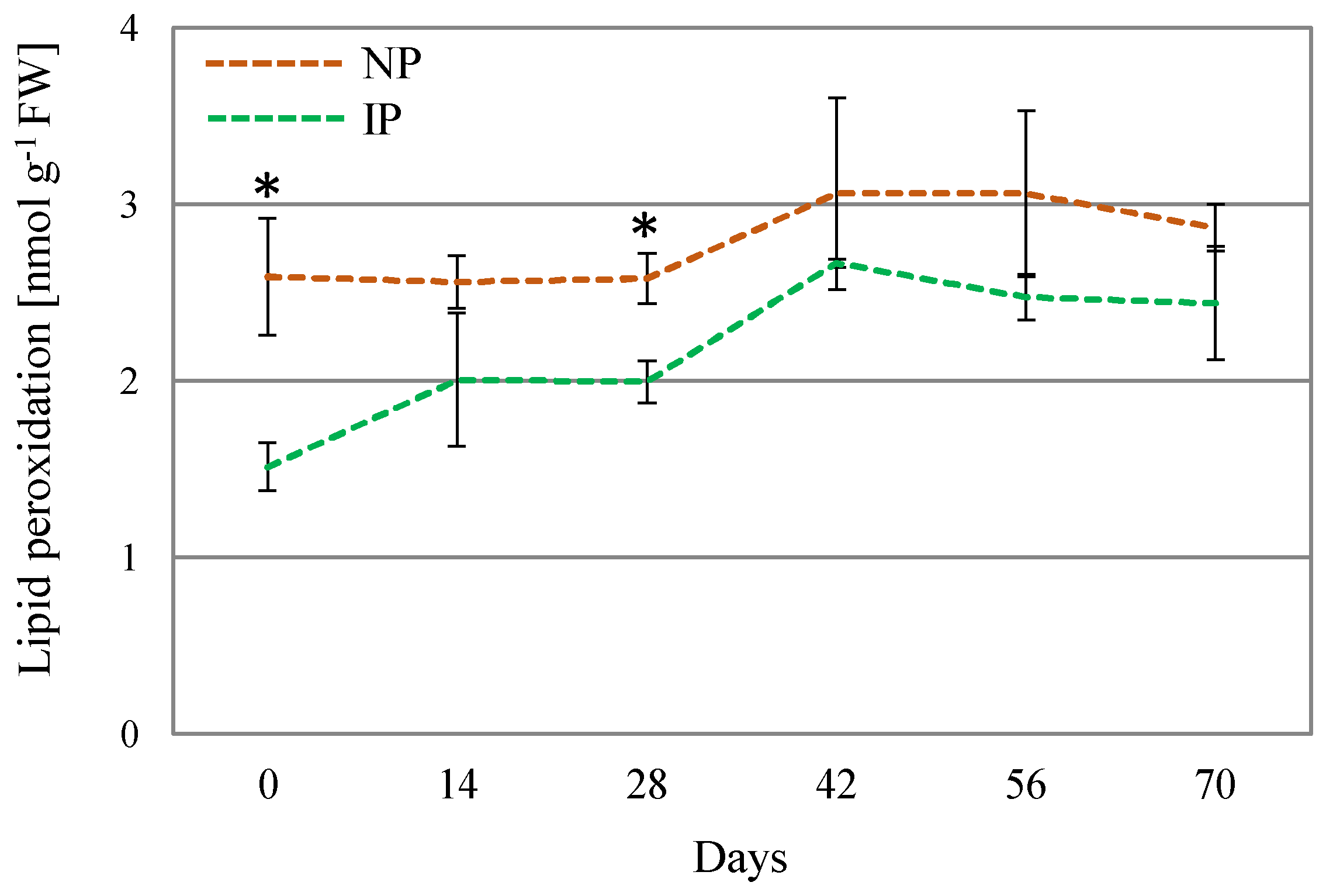
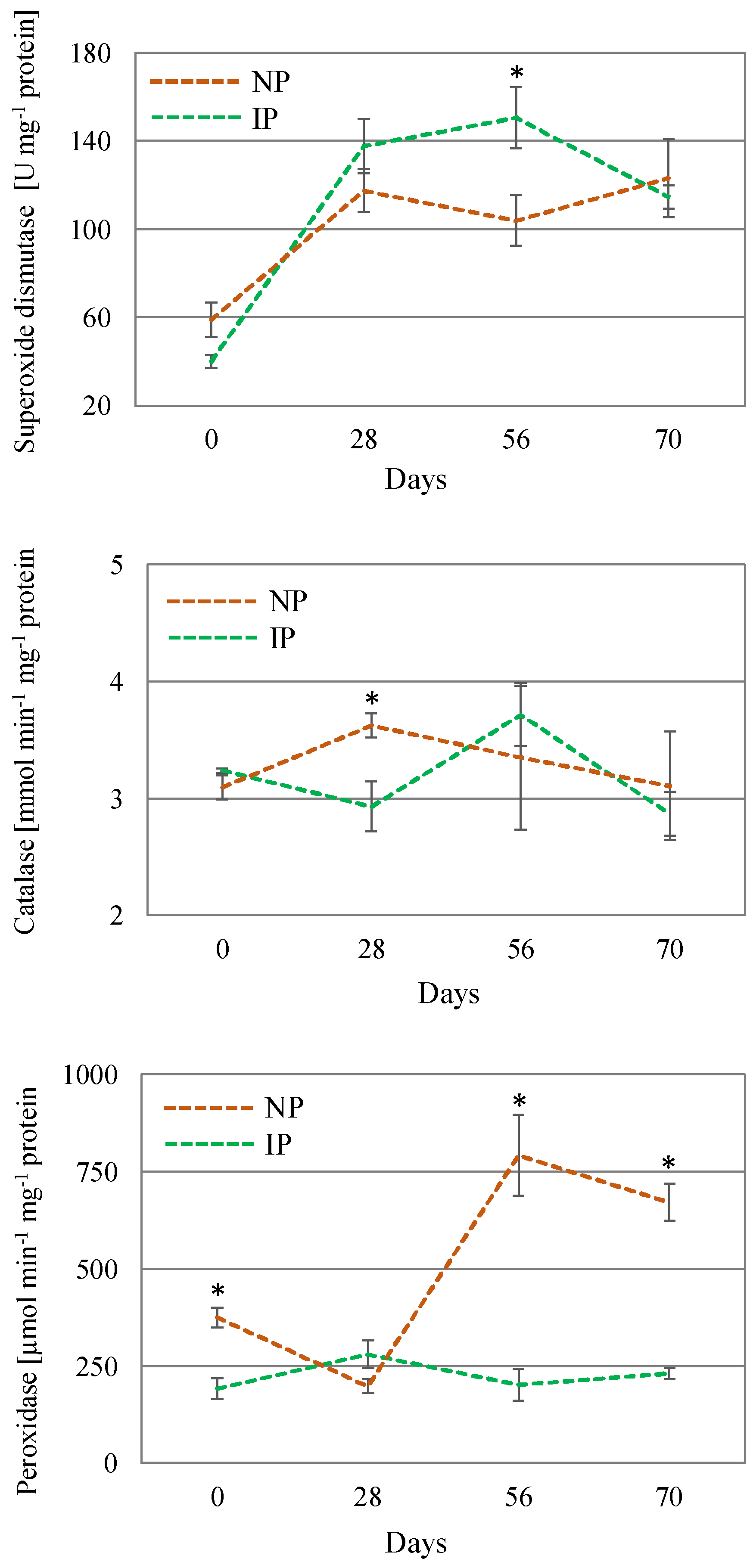
| g Kg−1 DW | mg Kg−1 DW | ||||||||||||
|---|---|---|---|---|---|---|---|---|---|---|---|---|---|
| Ca | Cl | Na | Fe | B | Cd | Co | Cr | Cu | Ni | Sr | Ti | Zn | |
| IP | 13.2 | 65.4 | 42.1 | 0.87 | 13.5 | 0.14 | 0.14 | 4.86 | 9.84 | 2.06 | 41.5 | 32.6 | 22.1 |
| NP | 16.4 * | 70.0 | 38.3 | 1.40 ** | 19.1 * | 0.18 * | 1.30 ** | 9.25 * | 30.2 ** | 3.84 * | 71.2 *** | 48.1 * | 33.4 * |
| g Kg−1 DW | mg Kg−1 DW | ||||||||||
|---|---|---|---|---|---|---|---|---|---|---|---|
| Cl | Na | NO3− | PO43− | SO42− | Li | Mn | Mo | Pb | Rb | Sr | |
| IP | 249 | 153 | 8.31 | 7.28 | 8.11 | 1.79 | 62.2 | 0.03 | 0.93 | 5.84 | 29.0 |
| NP | 195 ** | 150 | 19.2 ** | 15.3 * | 13.1 * | 2.96 * | 47.1 * | 1.65 * | 0.50 * | 9.65 * | 50.4 *** |
Disclaimer/Publisher’s Note: The statements, opinions and data contained in all publications are solely those of the individual author(s) and contributor(s) and not of MDPI and/or the editor(s). MDPI and/or the editor(s) disclaim responsibility for any injury to people or property resulting from any ideas, methods, instructions or products referred to in the content. |
© 2025 by the authors. Licensee MDPI, Basel, Switzerland. This article is an open access article distributed under the terms and conditions of the Creative Commons Attribution (CC BY) license (https://creativecommons.org/licenses/by/4.0/).
Share and Cite
Atrous, G.; Piqueras, A.; Diaz-Vivancos, P.; Hernández-Cánovas, A.; Hamed, K.B.; Hernández, J.A.; Barba-Espín, G. In Vitro-Selected Clones of the Halophyte Arthrocaulon macrostachyum Display Enhanced Salinity Stress Tolerance. Plants 2025, 14, 1164. https://doi.org/10.3390/plants14081164
Atrous G, Piqueras A, Diaz-Vivancos P, Hernández-Cánovas A, Hamed KB, Hernández JA, Barba-Espín G. In Vitro-Selected Clones of the Halophyte Arthrocaulon macrostachyum Display Enhanced Salinity Stress Tolerance. Plants. 2025; 14(8):1164. https://doi.org/10.3390/plants14081164
Chicago/Turabian StyleAtrous, Ghofrane, Abel Piqueras, Pedro Diaz-Vivancos, Ana Hernández-Cánovas, Karim Ben Hamed, José A. Hernández, and Gregorio Barba-Espín. 2025. "In Vitro-Selected Clones of the Halophyte Arthrocaulon macrostachyum Display Enhanced Salinity Stress Tolerance" Plants 14, no. 8: 1164. https://doi.org/10.3390/plants14081164
APA StyleAtrous, G., Piqueras, A., Diaz-Vivancos, P., Hernández-Cánovas, A., Hamed, K. B., Hernández, J. A., & Barba-Espín, G. (2025). In Vitro-Selected Clones of the Halophyte Arthrocaulon macrostachyum Display Enhanced Salinity Stress Tolerance. Plants, 14(8), 1164. https://doi.org/10.3390/plants14081164









